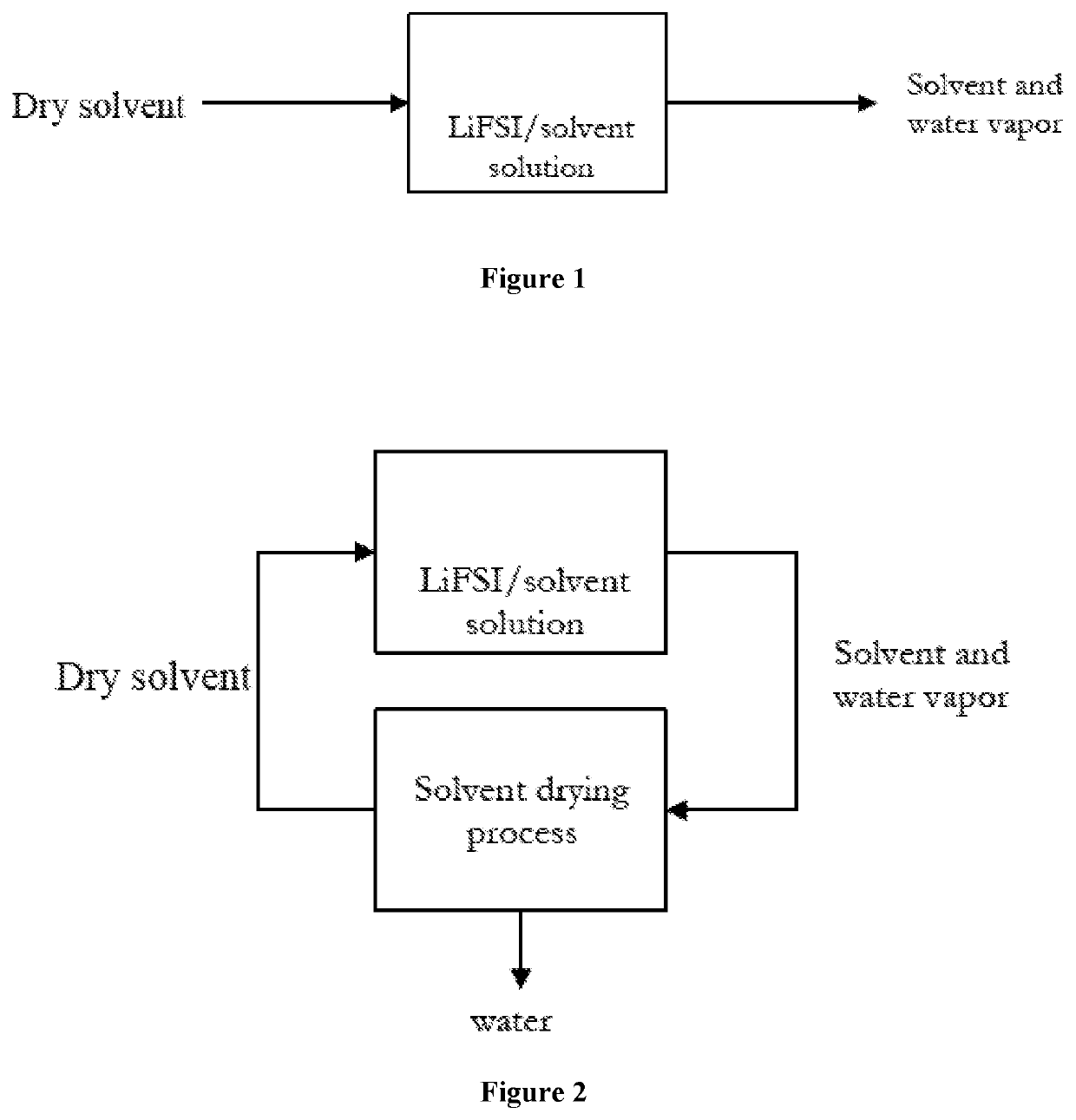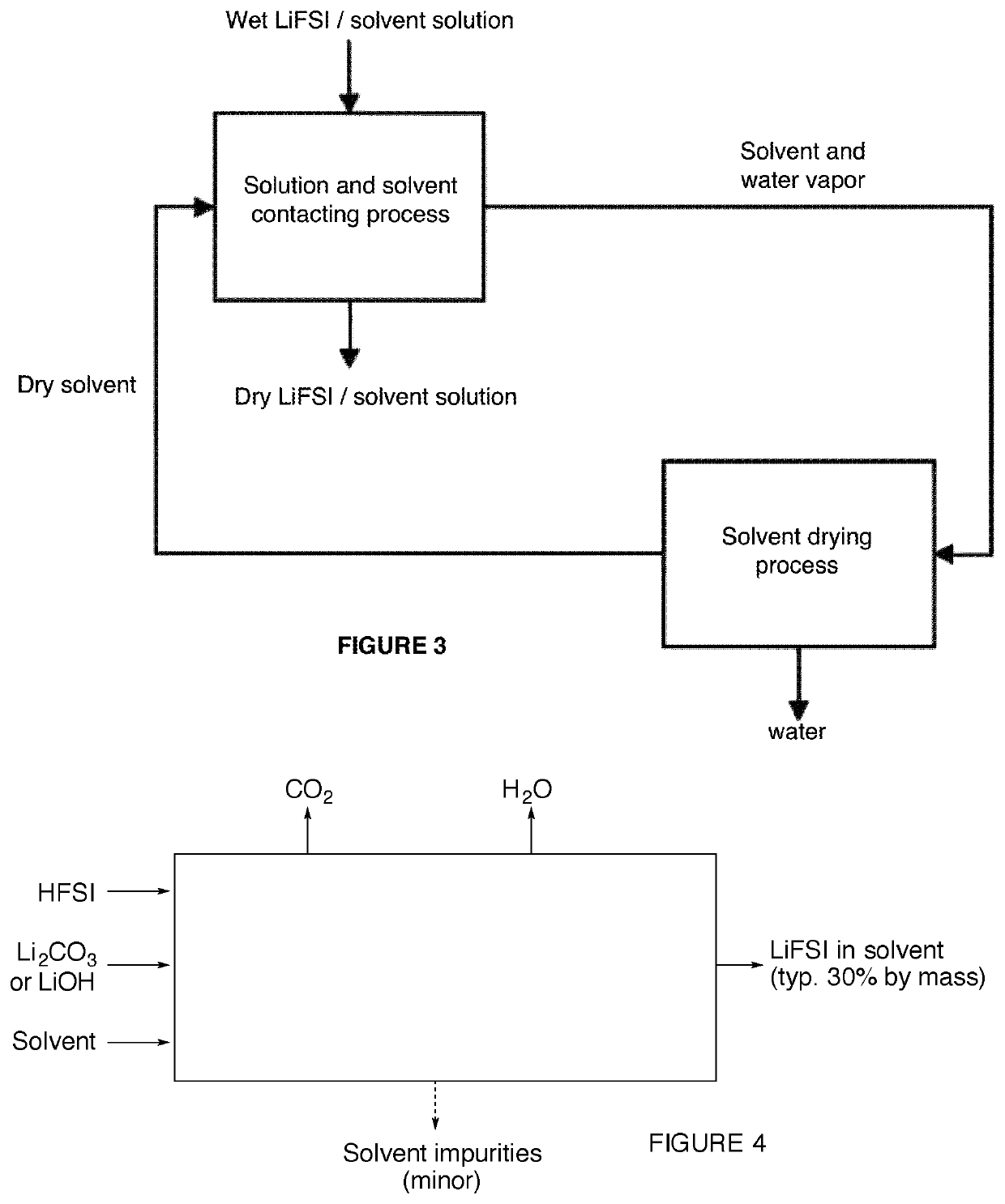Method for drying electrolyte solution
a technology of electrolyte solution and electrolyte, which is applied in the direction of vacuum distillation separation, cell components, separation processes, etc., can solve the problems of difficult and expensive removal of water from the electrolyte, inability to produce dry, and inability to stabilize lifsi/water mixture, etc., to achieve cost-effectiveness, reduce solvent use, and increase yield
- Summary
- Abstract
- Description
- Claims
- Application Information
AI Technical Summary
Benefits of technology
Problems solved by technology
Method used
Image
Examples
example 1
[0074]A wet solution of LiFSI and diethyl carbonate (DEC) was prepared by mixing 100 g of DEC, 54.6 g LiFSI, and 1.59 g water. The solution was found to have 1.0 wt % water from Karl Fischer titration. This solution was placed in a 1 L three-neck round bottom flask with a magnetic stir bar and a heating mantle. One flask neck was closed with a ported stopper through which a thermocouple was immersed in the LiFSI / DEC solution. Another neck was fitted with a 125 mL pressure equalizing addition funnel filled with 117.5 g DEC having 130 ppm, water as measured by Karl Fischer titration. The final neck was fitted with a vacuum port Liebig distillation head. A 1 L round bottom flask was attached to the receiving end of the distillation head. This receiving flask was immersed in an ice bath. The distillation condenser was cooled to −5° C. with an external chiller. A diaphragm vacuum pump was connected to the vacuum port of the distillation head and the pressure was reduced to about 15 torr....
example 2
[0076]A wet solution of LiFSI and ethyl methyl carbonate (EMC) was prepared by mixing 47.2 g LiFSI, 88.6 g EMC and 1.432 g water. The solution was found to have 1.06 wt % water by Karl Fischer titration. 123.0 g of this solution was placed in a 300 mL three-neck round bottom flask with a magnetic stir bar and a heating mantle. The flask was connected to the apparatus described in Example 1. The LiFSI / EMC solution was heated to about 42° C. under constant power from the heating mantle. Vacuum was applied at about 30 torr and the condenser was cooled to about −6° C. Dry EMC was added to the LiFSI / EMC solution from the addition funnel and boiling was observed with condensate collection in the receiving funnel. After the contents of the addition funnel was added, the water content of the LiFSI / EMC solution was measured by Karl Fischer titration and the addition funnel was refilled with dry EMC. Table 1 shows the amount of EMC added and the resulting water concentration in the LiFSI / EMC ...
example 3
[0080]A solution of LiFSI in water was prepared by mixing HFSI with lithium carbonate. In a jacketed flask equipped with a mechanical stirrer, 814 grams of water was added with 747 grams of lithium carbonate. 3700 g of HFSI was added dropwise to the reactor over the course of 3.5 hours, while maintaining the reactor temperature below 20° C. by circulating coolant through the jacket. After completing the addition of the HFSI, the reactor contents were drained and filtered, yielding an aqueous solution containing 78% LiFSI by mass. This solution was then mixed with DEC and dried using the methods of Example 1.
[0081]Process effluents were CO2, water and a minor solid impurity stream, (typically <1% of the LiFSI production rate). For efficiency, the HFSI feed was of high purity as shown in Table 2. Conversion was nearly quantitative as yields above 95% was achieved.
[0082]
TABLE 2HFSI used in Example 3Specificationvalue (ppmw)FluoridewChloride wSulfatewFluorosulfatewColorLight yellow to ...
PUM
| Property | Measurement | Unit |
|---|---|---|
| temperature | aaaaa | aaaaa |
| pressure | aaaaa | aaaaa |
| pressure | aaaaa | aaaaa |
Abstract
Description
Claims
Application Information
 Login to View More
Login to View More - R&D
- Intellectual Property
- Life Sciences
- Materials
- Tech Scout
- Unparalleled Data Quality
- Higher Quality Content
- 60% Fewer Hallucinations
Browse by: Latest US Patents, China's latest patents, Technical Efficacy Thesaurus, Application Domain, Technology Topic, Popular Technical Reports.
© 2025 PatSnap. All rights reserved.Legal|Privacy policy|Modern Slavery Act Transparency Statement|Sitemap|About US| Contact US: help@patsnap.com


